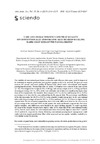Identificador persistente para citar o vincular este elemento:
https://accedacris.ulpgc.es/jspui/handle/10553/70028
| Título: | Carcass Characteristics And Meat Quality Of Conventionally And Organically Reared Suckling Dairy Goat Kids Of The Payoya Breed | Autores/as: | Guzmán, José Luis De La Vega, Francisco Zarazaga, Luis Ángel Argüello Henríquez, Anastasio Delgado-Pertíñez, Manuel |
Clasificación UNESCO: | 3104 Producción Animal | Palabras clave: | Convencional Farm Gender Grazing Systems Livestock Production System Organic Farm |
Fecha de publicación: | 2019 | Publicación seriada: | Annals of Animal Science | Resumen: | The viability of conventional goat farms, such as the native Payoya dairy goat, could be improved by switching to organic production, but product quality needs to be ensured. The present work assesses the carcass and meat quality of Payoya kids raised under conventional and organic grazing-based systems. Twenty-four kids (12 males, 12 females) were selected from each system (n = 48). The slaughter live weight (8.52 vs. 8.28 kg), cold carcass weight (4.44 vs. 4.29 kg) and farm dressing percentage (51.7 vs. 50 %) of the conventionally raised kids were significantly higher than those of the organic kids. The shoulder (first category) (21.7 vs. 22.3 %) and long leg (32 vs. 32.9 %) percentages were lower in the conventional than in the organic kids. The percentage contribution of the intermuscular fat (10.70 vs. 8.11 %) to the shoulder weight was greater in the conventional kids, while the percentage of muscle (59.7 vs. 57.2 %) and bone (24.7 vs. 22.8 %) were higher in the organic kids. For the chemical composition, there were only differences between the two sexes in the percentage of fat (6.64 and 7.99 % on dry matter, for male and female, respectively). For rheological variables, only differences were found in the water holding capacity (% water expelled), the meat of the organic females had a higher value (17 %) than that of the conventional females (14 %). For the meat colour, the conventional male kids returned the highest values for C∗ and H (14.32 and 64.34, respectively). Farms following conventional grazing-based management could easily switch to organic production. Most of the meat and carcass quality variables studied were very similar across the systems. | URI: | https://accedacris.ulpgc.es/handle/10553/70028 | ISSN: | 1642-3402 | DOI: | 10.2478/aoas-2019-0047 | Fuente: | Annals Of Animal Science[ISSN 2300-8733],v. 19 (4), p. 1143-1159, (Octubre 2019) |
| Colección: | Artículos |
Citas SCOPUSTM
2
actualizado el 09-ago-2020
Citas de WEB OF SCIENCETM
Citations
17
actualizado el 08-jun-2025
Visitas
70
actualizado el 02-mar-2024
Descargas
153
actualizado el 02-mar-2024
Google ScholarTM
Verifica
Altmetric
Comparte
Exporta metadatos
Los elementos en ULPGC accedaCRIS están protegidos por derechos de autor con todos los derechos reservados, a menos que se indique lo contrario.
